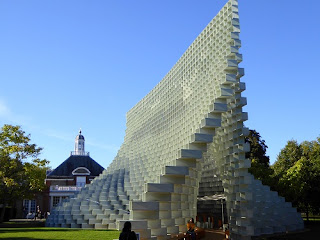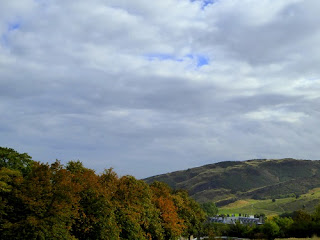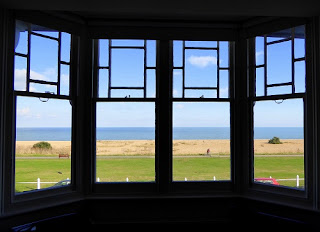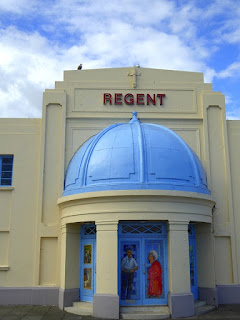Friday, 28 October 2016
City parks in Autumn
I count myself lucky to have caught so much rus in urbe over the past month or so, especially in Edinburgh and Leeds. There's also a virtue in seeing the same parts of London parks and gardens across the seasons, above all Kew Gardens, the Chelsea Physic Garden, Kensington Gardens/Hyde Park and Chiswick House Gardens (one of several sphinxes pictured above).
First stop is the most recent cockapoo/spoodle etc 'meet', usually held on the last Sunday of each month around the Serpentine Gallery in Kensington Gardens. My heart belongs to naughty Ted, of course, looking especially pert here
but it was also good to be able to introduce him to gentle Max, and their owners to each other. Max is circumspectly enquiring about the endless rough and tumble Ted enjoys, fangs out in play, with his best friend Archie
and I have to say the cutest 'poo of the morning had to be this shaggy one year old, just adorable.
After the break-up, and coffee outside the Serpentine Gallery, I went to look at the other pavilions erected for the first time nearby - better as an ensemble than individually, and offering good perspectives. This one is through Yona Friedman's modular structure
while Kunlé Adeyemi's Summer House is an inverse replica of Queen Caroline's Pavilion, seen beyond its central arch.
This year's star by the Bjarke Ingels Group, sixteenth among the best of the main Serpentine Pavilions, is now being dismantled. I feel lucky to have caught it for the last time on the most perfect afternoon.
Another blue-sky afternoon shed light on some Danish* junior bandsfolk who'd piled off a bus by the Albert Memorial and entertained me on my way to a Monday Opera in Depth class.
Meanwhile Kew's star attraction, the Hive, looks good in all weathers. I've devoted enough time to it already so no more pics from within, just a distant glimpse
and some pictorial reminders that when we last visited, the bee-friendly herbaceous borders were still going strong.
It's also the first time I've seen a gaggle of those most beautifully marked of all ducks, the Mandarins.
Not sure I'd clocked what the female of the species looked like either.
When I was a student in Edinburgh throughout the early 1980s, Calton Hill was very rarely a destination. Now that I stay a night or so a year at the quiet and cosy Parliament House Hotel when attending a Scottish Chamber Orchestra concert, it's on the doorstep and that whole east end of town, which gives way to so much nature, has become a stamping ground (hence the visits to the two exhibitions I wrote about recently). On this occasion I had the best room of all, right at the top, with a view directly across to the Dugald Stewart Monument on the hill which Robert Louis Stevenson used to chastise Edinburgh for commemorating Robert Burns less lavishly
as well as towards Salisbury Crags with the old Parliament Building in front
and Leithwards; here's a perspective slightly further round from the top of the hill which extends past Stockbridge and the New Town just as far as the top of the Forth Rail Bridge.
Calton Hill is now a popular tourist destination (I don't remember it being especially so in the 1980s), and in September the Chinese were flocking to Edinburgh. Yet I can only be proud of how beautiful this all is. Nobody minds now that William Henry Playfair's Grecian National Monument, begun to commemorate the fallen in the Napoleonic Wars, was left unfinished in 1829 and once dubbed, inter alia, 'the Pride and Poverty of Scotland'.
The central wing of Playfair's 1818 City Observatory is handsome
but I like better still the little temple on its east side.
Part of the building has now been requisitioned for Collective, an art group which was using one room to display the work of Hamish Young, homaging the Carrara marble quarries.
As for the views over which Stevenson waxed so lyrical, the classic one is with the Dugald Stewart Monument in the foreground looking west down Princes Street towards the castle
while looking over to Arthur's Seat,
you can well believe you're in the deepest Scottish countryside at one viewpoint, with no hint of the buildings in the valley between.
Holyrood Palace looks very handsome from above
and it was there I headed for the first of two superb exhibitions I've already chronicled in some detail. On the previous evening, I took a customary stroll from Parliament House Hotel to the Usher Hall via George Street and Princes Street Gardens
with the sun dazzling the eyes from due west, silhouetting the monument to the Royal Scots Greys Regiment.
A fortnight later I took another pleasant train journey north, this time to Leeds to review Opera North's excellent new production of Britten's Billy Budd for The Arts Desk. I stayed with fellow contributor Graham Rickson and his partner and daughter in Chapel Allerton, a good place to be based for an excursion to what Leeds claims is the largest public park in Europe, Roundhay. Surely Richmond** must be bigger? No matter, there are so many gems studded around the park, not least Canal Gardens over the main road
and somewhat Chelsea Flower Show-ish recreations of famous sites like the Generalife of the Alhambra.
But the main glory is the sweep from the Mansion,
where I had excellent Eggs Benedict and smoked salmon for lunch, down to the Waterloo Lake. The kid on the pavement and her brother had been assembling neat rows of conkers.
Connecting to the Greek Revival on Calton Hill, Thomas Nicholson, who bought an estate which had once been a Norman hunting ground, had his residence begun in 1811. In another link, former soldiers from the Napoleonic Wars worked on the construction of the lower lake, hence its name.
As well as this Swan of Tuonela, there were plenty of Indian families sitting in the sun.
The walk back was a match for the beauties of Richmond Park or Hampstead Heath
with autumn crocuses flourishing in the shade
and plenty of green around the gate, outside which I took the No. 3 bus back to the centre of Leeds and (eventually) the train home.
By way of a Chiswick coda, the final snaps record a bike ride last Saturday afternoon, taken for exercise's sake since we'd postponed our Pilgrims' Way walk until Sunday. A wise decision, as it turned out, but the grey light in the park
cleared as I cycled back, the setting sun lighting up trees by the Thames
and the tower of Chiswick Parish Church
with some fine rose-lit clouds over the river.
Next photojournal stop: the walk from Borough Green to Trottiscliffe Church and Neolithic barrow and back - real countryside.
*Laurent in a comment below had noticed the flag, which I hadn't, and pointed out the correct nationality. I had 'German' because that was the language on the side of the bus from which they'd dismounted.
**Digression re Richmond Park: bring it on, my new Europe-friendly party of choice, and away with you, craven scaremonger Zac Goldsmith. High hopes for this one.
Wednesday, 26 October 2016
Deception: no Humoresque
Having deeply admired Hollywood's most 'musical' drama, Humoresque, with its climactic scene of a desperate Joan Crawford drifting along a beach at night while her character's beloved violinist Paul Boray, played by John Garfield, performs Franz Waxman's 10-minute Tristan Fantasia with Oscar Levant and orchestra, I finally got hold of another film in which the score is central. Deception (1946) stars Crawford's arch rival Bette Davis and features another prominent score, this time by Korngold.
Paul Henreid is cellist Karel Novak, who suffered terrible things in Europe during World War Two before coming to America to make his name. So far, so good. But the woman with whom he's disastrously reunited is Davis in most affected mode, and she's been having an affair with tyrannical if not downright Svengaliesque composer Alexander Hollenius (Claude Rains, third of the winning trio from Now, Voyager: fun but perhaps inappropriately camp as a composer with very bad taste in luxury furnishings).
The silly story revolves around Hollenius wielding the power of his music to get Novak to play his Cello Concerto, for which Korngold provides appropriately acidic/melodramatic/romantic music. The cellist is Eleanor Aller; some remarkably fine Chopin (or is it Beethoven? I've forgotten already), not very convincingly mimed by Davis at the keyboard for a wedding party scene, is played by the great Shura Cherkassky.
The original 1927 play, Louis Verneuil's Monsieur Lambertine, must have been rather dreadful on stage, with a daft denouement, but these high-charisma folk and director Irving Rapper do bring a visual style to it. Unfortunately, whereas Humoresque gave a very truthful account of a dedicated violinist's rise to the heights and plausible concert scenes to show why he deserves to be there - as recounted in the blog on that film, Isaac Stern holds the bow for and someone else does the fingering, and I can assume something similar's going on for Henreid here - Deception regurgitates the usual cliches about a player so hungry for fame that he'll do illogical things (though there's quite an amusing caricature of an orchestral cellist all too ready to jump on to his platform if he falters). Histrionic fun, but not a great movie.
A refreshingly low-key, oblique approach to Hollywood ennui and alienation is taken by Sofia Coppola in Somewhere (2010). The washed-up emptiness of a star's life as represented by the laid-back Stephen Dorff, who has enough easy Jack-Nicholsonesque sexiness for you to understand why his character, Johnny Marco, might have got where he has, offers some amusing scenes, not least the ones early on where pole-dancing twins perform perfunctory routines in Marco's hotel room at the (not too appealing) Chateau Marmont.
The way his 11-year-old daughter Cleo, played with real charm by Elle Fanning, comes back into his life is just as casual. Which makes the final peripetaia all the more affecting. Quite some gem, this, showing Coppola junior's originality as surely as Lost in Translation and the delicious Marie Antoinette.
And now that autumn's here, we must avail ourselves again of the Picture House pass and start catching up with the latest, which haven't been on the agenda over the summer months.
Monday, 24 October 2016
Weekend Deal: a room with a view
Grass, shingle, sea and sky from the first floor window of friends who have a house at the Walmer end of Deal. We spent a happy time there over the second October weekend just after my return from Edinburgh (which meant we didn't go down until Saturday morning). And 'A Room with a View' is not inappropriate, at least as far as the Coward version goes. He turns out to have been the intermediary in the salvation of what is now Deal's conservation area, a warren of small houses and lanes between the sea front and the High Street.
In short, Charles Hawtrey lived here in what by all accounts were his bitter and acid later years. There's a plaque to prove it.
and I'm afraid that I am playing in the below image to J's insistence that I bear an uncanny resemblance.
When the area came up for a potential second demolition after World War Two, Charlie got on the blower to his good friend Noely, who had a place just down the coast. And Noely had a word with his dear pal the Queen Mum, Warden of the Cinque Ports. She loved Walmer Castle best of the royal homes, apparently, and who can blame her?
So by royal command the place was spared and seems safe in perpetuity. We learnt this from another part-time Deal resident, with whom we had a coffee before Sunday lunch. His partner's mother finally twigged what sort of a place it was from the large number of gentlemen out walking chichi little dogs. It has long been thus thanks to the presence of the Marines, whose time here was of course marked by terrible tragedy when the IRA bombed the bandstand and 11 lives were lost.
Anyway I've never seen more little dogs in one place than along the promenade between Walmer and Deal, which we traversed quite a few times. I sorrow to say that dog poo is a rather predominant smell, as the second notice down on one of the fish huts makes clear.
That apart, it's delightful to stroll up and down (a plan to head for St Margaret-at-Cliffe on foot was abandoned owing to the last weekend over which I had to endure the persistent pain and trouble of my stent - now removed, so we went on a long walk along the Pilgrims' Way yesterday).
Our first Sunday stroll was Walmerwards, shared with a group of local walkers young and old,
all the while admiring the clarity of the French coast
and spending all too short a time around Walmer Castle due to the social schedule (I went round it as a kid during annual Whitsun weeks visits with an aunt's place at Tankerton as a base, and still remember how cosy it was for a castle). A circumnavigation of the outside, at least, was possible.
Then it was back and onwards to Deal itself, passing the various flotsam and jetsam around the white huts
and the remnants of weekday sales
plus some more picturesque views out with old boats
and of course Deal's own, more hemmed-in castle
and a few incidental seaside pleasures like the old cinema, which has had some enlivening murals added
until we eventually looked along this side of the channel towards the white cliffs of Ramsgate.
After a leisurely lunch back at the Walmer end, I took yet another walk in different, later-afternoon light
to meet the others at the celebrated Deal Beach (Ice Cream) Parlour, this time to be reunited with the youngest goddaughter, Mirabel aka Dancing Delice, along with her ma and pa. She was got up in her best Alice gear owing to the bond we now share with Lewis Carroll. Here she is with dad Kit at the celebrated Ice Cream Parlour
where immense fun was to be had from the 20p plastic eggs with gifts inside laid by a twirling musical hen. And similar simple pleasures followed simply by throwing stones into the sea (not even any skimmers)
and inviting some unfathomable rushing up and down game with this particular teddy (alas, not Special, who never leaves Aunt Choppy's sight)
while J and Edwina took a spin along what must be the ugliest pier in Britain - but a pier's a pier for all that, and they saw some amusing spectacles.
This slice of London by the Sea has plenty of delights; even if I associate looking at the sea with waiting for the end, the shifting skies over the channel could keep me amused for days on end.
Subscribe to:
Posts (Atom)












































































